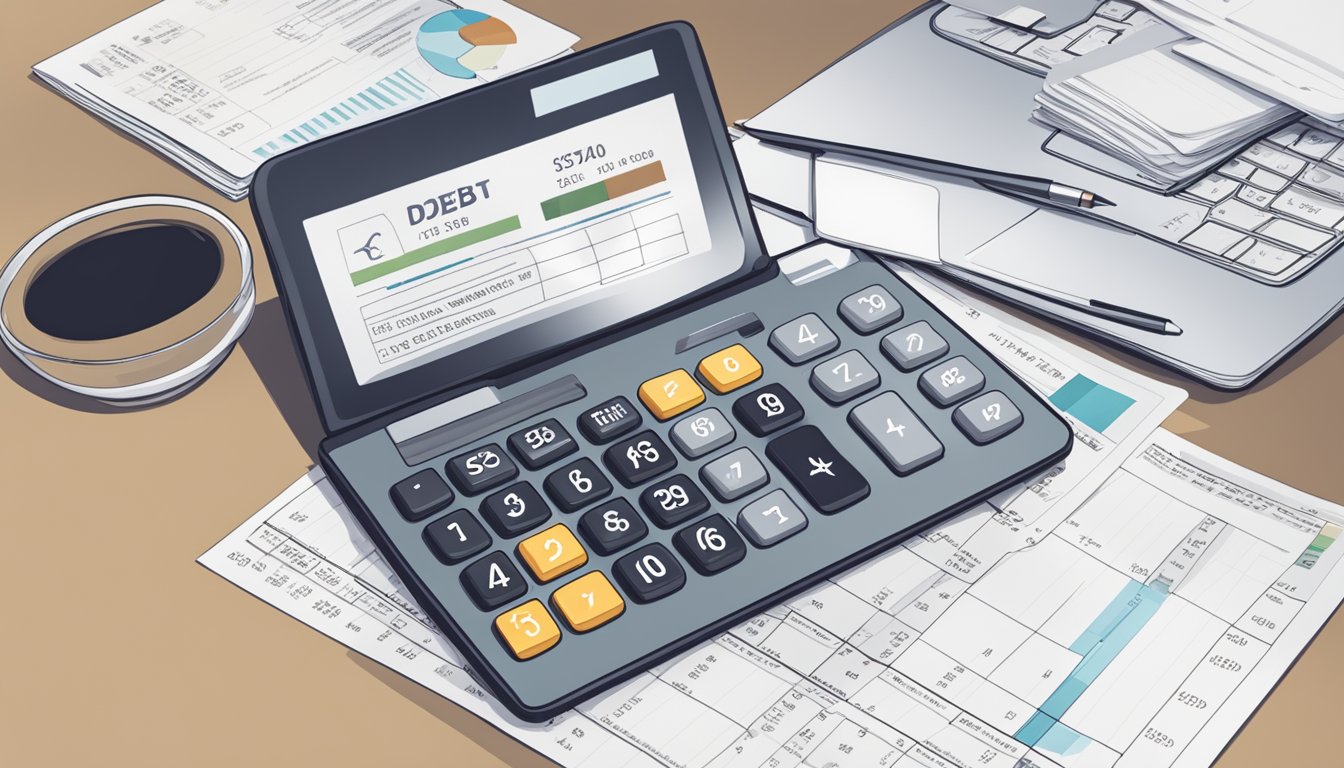If you’re a potential homeowner in Singapore, you may have heard of the Total Debt Servicing Ratio (TDSR). This policy, introduced by the Monetary Authority of Singapore in 2013, is designed to help ensure that borrowers do not overextend themselves financially. Essentially, the TDSR limits the amount of debt you can take on each month to 60% of your gross monthly income.

To calculate your TDSR, you’ll need to add up all your monthly debt obligations, including your mortgage payments, credit card bills, and any other loans or debts you have. Then, you’ll divide that total by your gross monthly income. If the resulting percentage is 60% or less, you’ll likely be eligible for a loan. If it’s higher, you may need to pay down some of your debt or look for a less expensive property.
It’s important to note that the TDSR applies to all property loans in Singapore, regardless of the type of property or the financial institution providing the loan. However, there are some exceptions and special circumstances that may affect your eligibility. Keep reading to learn more about how the TDSR works and what you need to know to navigate the process successfully.
Key Takeaways
- The TDSR limits the amount of debt you can take on each month to 60% of your gross monthly income.
- To calculate your TDSR, you’ll need to add up all your monthly debt obligations and divide by your gross monthly income.
- The TDSR applies to all property loans in Singapore, but there are some exceptions and special circumstances that may affect your eligibility.
Understanding Total Debt Servicing Ratio (TDSR) in Singapore

Concept of TDSR
If you are planning to take a loan in Singapore, it is essential to understand the concept of Total Debt Servicing Ratio (TDSR). TDSR is a framework instituted by the Monetary Authority of Singapore (MAS) to ensure that borrowers do not overextend themselves with loans. It refers to the percentage of your gross monthly income that goes towards paying off your monthly debt obligations. This includes your home loan (mortgage) and other liabilities like credit card debt and personal loans.
TDSR Calculation
To calculate your TDSR, you need to add up all your monthly debt obligations and divide it by your gross monthly income. The resulting percentage should be less than or equal to 55%. For example, if your monthly income is $3,000 and your monthly debt obligations are $1,500, your TDSR would be 50%.
Impact on Borrowers
TDSR has a significant impact on borrowers. It limits the amount of debt you can take on and ensures that you do not overextend yourself financially. If your TDSR is too high, you may not be able to get a loan, or you may only be able to get a loan with a higher interest rate. It is, therefore, essential to keep your TDSR below 55% to increase your chances of getting a loan with favourable terms.
To help you calculate your TDSR, you can use a TDSR calculator, which is available online. This will give you an idea of how much you can afford to borrow based on your income and monthly debt obligations.
In summary, understanding TDSR is crucial if you are planning to take a loan in Singapore. It is a framework that ensures you do not overextend yourself financially and limits the amount of debt you can take on. Keep your TDSR below 55% to increase your chances of getting a loan with favourable terms.
Eligibility Criteria for Loans and TDSR Implications

If you are planning to apply for a loan, you need to be aware of the Total Debt Servicing Ratio (TDSR) rules in Singapore. TDSR is a framework that regulates the amount of debt that a borrower can take on. This is to ensure that borrowers can manage their debt repayments and avoid defaulting on their loans.
Income Considerations
When assessing your eligibility for a loan, lenders will consider your income. This includes your gross monthly income, which is your income before taxes and other deductions. Lenders will also take into account your other debt obligations, such as credit card debt, car loans, and other loans.
Property Loan Eligibility
If you are planning to take out a property loan, TDSR rules apply to you. The TDSR threshold for property loans is set at 60%. This means that your total debt repayments, including your property loan, should not exceed 60% of your gross monthly income.
To calculate your TDSR, lenders will take into account your income, other debt obligations, and the loan tenure. The loan tenure is the length of time over which you will repay your loan. The longer the loan tenure, the lower your monthly repayments, but the higher the total interest you will pay over the life of the loan.
Other Loan Types Affected by TDSR
TDSR rules also apply to other loan types, such as unsecured loans and personal loans. The TDSR threshold for these loans is set at 60%. This means that your total debt repayments, including your other loans, should not exceed 60% of your gross monthly income.
If you are planning to take out a loan, it is important to understand the TDSR rules and how they will affect your eligibility. Make sure you calculate your TDSR before applying for a loan to ensure that you can manage your debt repayments.
The Role of Financial Institutions in TDSR Compliance

Financial institutions play a crucial role in ensuring that borrowers comply with the Total Debt Servicing Ratio (TDSR) rules in Singapore. As a borrower, it is important to understand the credit assessment procedures that banks use to determine your TDSR and how refinancing can affect your TDSR.
Credit Assessment Procedures
Banks use a set of credit assessment procedures to determine a borrower’s TDSR. These procedures take into account the borrower’s gross monthly income, current debt obligations, and other financial commitments. The bank will also consider the borrower’s credit score, employment history, and other factors that can affect their ability to repay the loan.
It is important to note that financial institutions can adopt more conservative practices as long as they are compliant with the Monetary Authority of Singapore’s (MAS) rules. This means that some banks may have stricter credit assessment procedures than others.
Refinancing and TDSR
Refinancing can affect a borrower’s TDSR. When refinancing, a borrower should consider the impact of the new loan on their TDSR. If the TDSR is too high, the borrower may not be able to refinance their existing loan.
It is important to note that refinancing can also be a way to improve a borrower’s TDSR. For example, if a borrower has several high-interest loans, they can consolidate these loans into a single loan with a lower interest rate. This can reduce the borrower’s monthly debt obligations and improve their TDSR.
In conclusion, financial institutions play a crucial role in ensuring that borrowers comply with the TDSR rules in Singapore. As a borrower, it is important to understand the credit assessment procedures that banks use to determine your TDSR and how refinancing can affect your TDSR. By understanding these factors, you can make informed decisions about your finances and ensure that you are compliant with the TDSR rules.
Singapore’s Property Market and TDSR Cooling Measures

If you are a Singaporean looking to purchase a residential property, it is important to understand the Total Debt Servicing Ratio (TDSR) and its impact on the property market. The TDSR is a cooling measure implemented by the Singapore government to prevent property speculation and over-leveraging. In this section, we will explore the effects of the TDSR on the property market and property speculation.
TDSR as a Cooling Measure
The TDSR is a ratio that measures the percentage of your gross monthly income that goes towards repaying your debt obligations, including your mortgage. The Singapore government implemented the TDSR as a cooling measure to prevent property speculation and over-leveraging. The TDSR ensures that borrowers do not overextend themselves financially and can afford their mortgage repayments.
The TDSR applies to all residential properties, including HDB flats and executive condominiums. The TDSR limits the amount of money you can borrow for your mortgage based on your income and debt obligations. The TDSR threshold was lowered from 60% to 55% in December 2021, limiting how much homebuyers can borrow for their mortgages.
Effects on Property Speculation
The TDSR has had a significant impact on property speculation in Singapore. It has prevented property buyers from over-leveraging and has helped to stabilise the property market. The TDSR has also increased the affordability of residential properties, making it easier for Singaporeans to purchase their own homes.
The TDSR has also had an impact on the HDB market. The Singapore government lowered the Loan-to-Value (LTV) limit for HDB housing loans from 85% to 80% in September 2022. This means that homebuyers need to have a larger down payment when purchasing an HDB flat.
In conclusion, the TDSR is an important cooling measure that has had a significant impact on the property market in Singapore. It has prevented property speculation and over-leveraging and has increased the affordability of residential properties. If you are looking to purchase a residential property in Singapore, it is important to understand the TDSR and its impact on your mortgage repayments.
Navigating TDSR: Tips and Strategies for Potential Homeowners

If you are a Singaporean looking to purchase a property, it is important to understand Total Debt Servicing Ratio (TDSR) and how it can affect your ability to obtain a loan. TDSR is a metric used by financial institutions to assess your ability to service your debt obligations. Here are some tips and strategies to help you navigate TDSR.
Strategies for Loan Approval
To increase your chances of loan approval, you can consider the following strategies:
- Debt Reduction Plan: If you have existing debts, consider a debt reduction plan to lower your monthly debt obligations. This can help you meet the TDSR threshold of 60% or lower.
- Financially Prudent: Be financially prudent by avoiding over-borrowing and over-leveraging. This can help you maintain a healthy TDSR and improve your chances of loan approval.
- Increase Your Income: Consider ways to increase your income, such as taking on a side job or negotiating a raise at work. This can help you improve your TDSR and increase your chances of loan approval.
Planning for Financial Prudence
Planning for financial prudence is crucial when it comes to TDSR. Here are some tips to help you plan for financial prudence:
- Determine Your Budget: Determine your budget by taking into account the cost of the property, your monthly income, and your monthly debt obligations. This can help you avoid over-borrowing and over-leveraging.
- Create a Monthly Budget: Create a monthly budget to help you manage your finances and ensure that you have enough funds to service your debt obligations.
- Save for a Down Payment: Save for a down payment to reduce the amount of money you need to borrow. This can help you maintain a healthy TDSR and improve your chances of loan approval.
In conclusion, understanding TDSR is crucial when it comes to purchasing a property in Singapore. By following the tips and strategies outlined above, you can improve your chances of loan approval and maintain financial prudence.
Frequently Asked Questions

How can you compute your Total Debt Servicing Ratio for a property loan in Singapore?
To calculate your Total Debt Servicing Ratio (TDSR) for a property loan in Singapore, you need to add up all your monthly debt obligations, including your home loan, credit card debt, and personal loans. Then, divide the total by your gross monthly income. The resulting percentage should be less than or equal to 55%.
What exemptions exist for the Total Debt Servicing Ratio in Singapore’s lending policies?
There are certain exemptions to the TDSR rules in Singapore’s lending policies. These exemptions apply to borrowers who have exceptional circumstances, such as those who are refinancing existing loans or those who have a good credit history. The Monetary Authority of Singapore (MAS) has set guidelines on these exemptions, and you should check with your lender to see if you qualify.
What’s the current limit set for the Total Debt Servicing Ratio when applying for a loan?
The current limit set for the Total Debt Servicing Ratio when applying for a loan in Singapore is 55%. This means that your monthly debt obligations, including your home loan, credit card debt, and personal loans, should not exceed 55% of your gross monthly income.
How does the Total Debt Servicing Ratio differ for private properties compared to HDB flats?
The Total Debt Servicing Ratio (TDSR) rules apply to both private properties and HDB flats in Singapore. However, the TDSR calculation for HDB flats is slightly different. For HDB flats, the TDSR calculation takes into account the monthly instalment of the HDB loan, which is capped at 30% of the borrower’s gross monthly income.
Could you explain the difference between Mortgage Servicing Ratio and Total Debt Servicing Ratio?
The Mortgage Servicing Ratio (MSR) and Total Debt Servicing Ratio (TDSR) are both used to calculate the maximum amount of loan that you can borrow. The MSR is used specifically for calculating the loan amount for HDB flats, while the TDSR is used for all other types of loans. The MSR takes into account only the monthly instalment of the HDB loan, while the TDSR takes into account all monthly debt obligations.
At what interest rate is the Total Debt Servicing Ratio calculated for Singapore loans?
The Total Debt Servicing Ratio (TDSR) calculation for Singapore loans is based on the prevailing interest rate at the time of application. This means that the TDSR calculation will vary depending on the interest rate of the loan. It’s important to keep this in mind when applying for a loan, as a higher interest rate will result in a lower loan amount that you can borrow.




